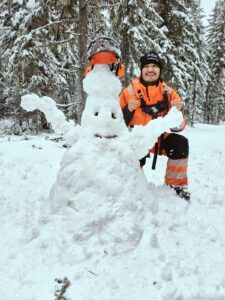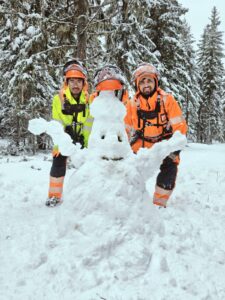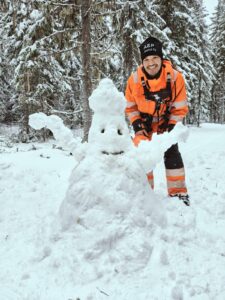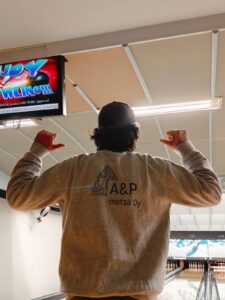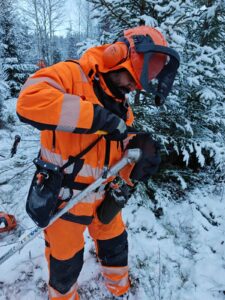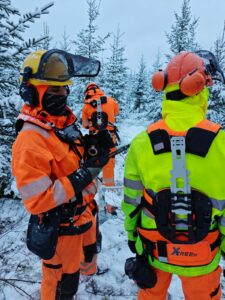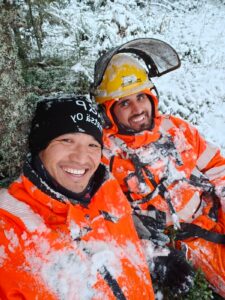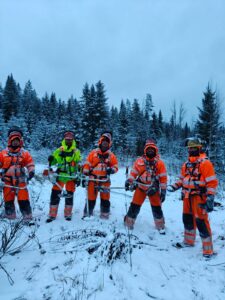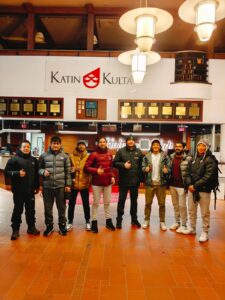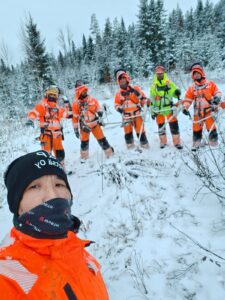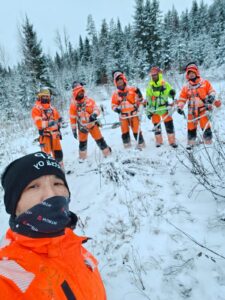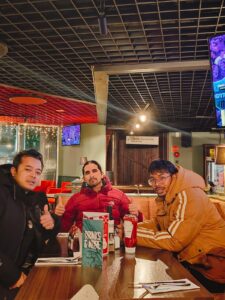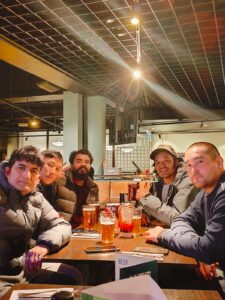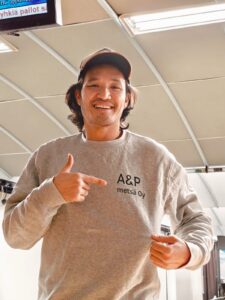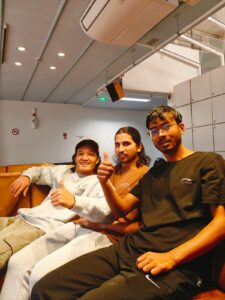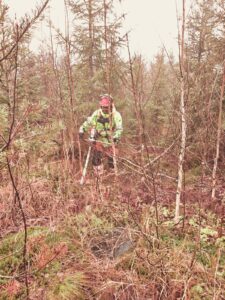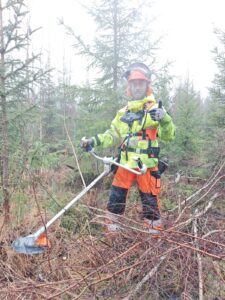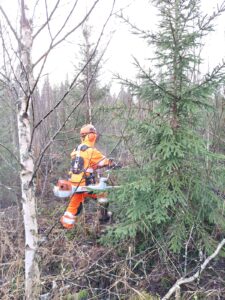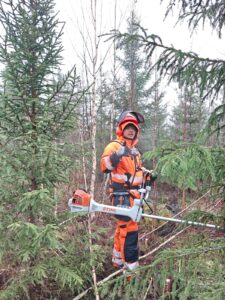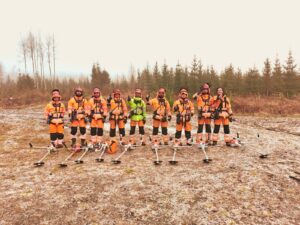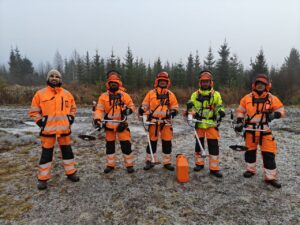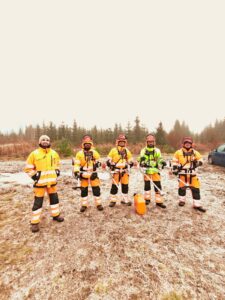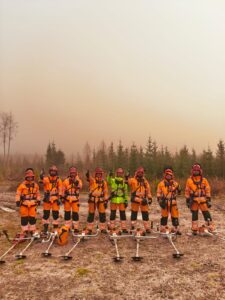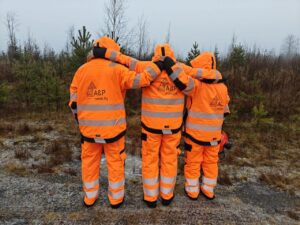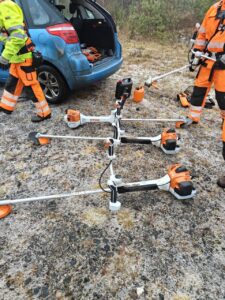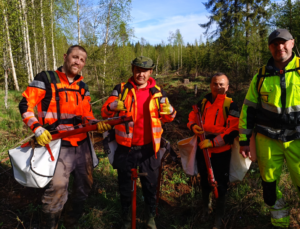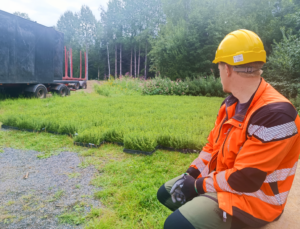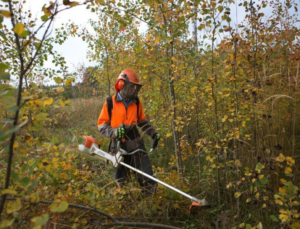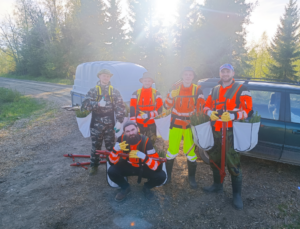Back to nature
Download brochureFinland
Welcome to our company's website!
We are a Finnish company specializing in forest care. Our goal is to maintain nature in harmony with modern standards of quality and environmental responsibility.
Our team consists of international professionals from Ukraine, Belarus, and Nepal. We combine experience, knowledge, and shared values to ensure high-quality work and a personalized approach to each of our clients.
We believe that responsible forest care is the key to its health and longevity. That's why we approach every task with the utmost precision and always meet deadlines. We are proud of our reputation as a reliable partner and are always ready to offer the best solutions for forest care.
Thank you for choosing us!
Sowing, planting, and additional planting.

Spruce seedlings are planted in cultivated soil as evenly as possible, 1600 pcs/ha (Lapland 1800 pcs/ha).
The seedlings are planted deep enough and in a straight position into the center of a mound or patch at least 20 cm from the edge of the humus. The seedlings to be planted must be in good condition, thawed, and moist. Protective strips around water bodies and small waters are left uncultivated. Lakes and ponds 10 m. Rivers and streams 15 m. Natural and natural-like
rivers, streams, and springs 20 m. The work includes: 1) Navigating to the site using a map or coordinates, 2) Sufficient watering of the seedlings and transportation from the intermediate storage to the planting site (max. 300 m), 3) Self-monitoring of work quality and
reporting of any unusual situations, 4) Notification of start and at the end of the work site, reporting the implemented surface areas (ha) and seedling usage (pcs) to the contractor, 5) Bundling of empty seedling boxes
and returning them to the nursery or a separately agreed place, disposable seedling bags and boxes
must be recycled. The contractor must be provided with the origin details of the seedling material (plant passport
or at least a certificate of origin identifier). The work is carried out according to the guidelines of the Forest Cultivation Guide (Metsäteho 2002). Equipment requirement: Planting equipment corresponding to the seedling material (contractor's own), protective gloves, and
hand washing facilities.
Schedule requirement:
Spring planting sites must be completed by the end of June.
Autumn planting is carried out in August-September.
Self-monitoring guideline:
Self-monitoring test plot measurements are based on
measurements made at the work site according to the test plot number as cultivation work progresses.
Locations
Test plot locations are selected from representative parts of the work site. The number of test plots at the work site
is determined by the area as follows. From work sites under 1 ha, 4 test plots each. From work sites over one hectare, +1
test plot per every additional 0.5 ha. Maximum 10 test plots per work site. Cultivation sites are measured from a circular test plot.
At the center of the test plot, a rotation is made, and the number of properly
planted seedlings/sowing sites within the formed circle is counted (pcs/ha). The final assessment of the work site is filled out according to the given instructions when the work site is completed.
Pine seedlings are planted into cultivated soil as evenly as possible at 1800 pcs/ha. The seedlings are planted
sufficiently deep and in a straight position into the center of a mound, patch, or furrow, at least 20 cm from the edge of the humus.
The seedlings to be planted must be in good condition, thawed, and moist. Buffer zones around water bodies and small waters are left
uncultivated. Lakes and ponds 10 m. Rivers and streams 15 m. Natural and natural-like rivers, streams,
and springs 20 m. The work includes: 1) Navigating to the site using a map or coordinates, 2) Sufficient
watering and transporting the seedlings from the intermediate storage to the planting site (max. 300 m), 3) Self-monitoring of work quality and reporting
of any unusual situations, 4) Notification of start and at the end of the work site, reporting the specific implementation area (ha)
and seedling usage (pcs) to the contractor, 5) Bundling empty seedling boxes and returning them
to the nursery or a separately agreed location, disposable seedling bags and boxes must be recycled.
The contractor must be provided with origin information of the seedling material (plant passport or at least
a certificate of origin identifier). The work is carried out according to the guidelines of the Forest Cultivation Guide (Metsäteho 2002).
Equipment requirement:
Planting equipment appropriate to the seedling material (contractor's own), protective gloves, and
hand washing facilities.
Schedule requirement:
Spring planting can continue as long as there is no risk of breaking the top shoot,
but no later than mid-June. Autumn planting is carried out in August-September.
Self-monitoring guideline:
Self-monitoring test plot measurements are based on area-based measurements conducted at the work site as the cultivation work progresses. Test plot locations are selected from different parts of the work site
from representative locations. The number of test plots at the work site is determined by the area as follows. From work sites
under 1 ha, 4 test plots each. From work sites over one hectare, +1 test plot per each additional 0.5 ha. Maximum 10 test plots
per work site. Cultivation sites are measured from a circular test plot. At the center of the test plot, a rotation is made and
the number of properly planted seedlings/sowing sites within the formed circle is counted
(pcs/ha). The final evaluation of the work site is filled out according to the given instructions when the work site is completed
Silver birch seedlings are planted in cultivated soil as evenly as possible at 1600 pcs/ha. The seedlings are planted
sufficiently deep and in a straight position in the center of a mound or patch at least 20 cm from the edge of the humus.
The seedlings to be planted must be in good condition, thawed, and moist. Buffer zones around water bodies and small waters are left
uncultivated. Lakes and ponds 10 m. Rivers and streams 15 m. Natural and natural-like rivers, streams,
and springs 20 m. The work includes: 1) Navigating to the site using a map or coordinates, 2) Sufficient
watering of the seedlings and transport from the intermediate storage to the planting site (max. 300 m), 3) Self-monitoring of work quality and reporting
of exceptional situations, 4) Start notification and at the end of the work site, reporting the specific implementation area (ha)
and seedling usage (pcs) to the contractor, 5) Bundling of empty seedling boxes and returning them
to the nursery or a separately agreed place, disposable seedling bags and boxes to be delivered for recycling.
The contractor must be provided with the origin details of the seedling material (plant passport or at least
a certificate of origin identifier). The work is carried out according to the guidelines of the Forest Cultivation Guide (Metsäteho 2002).
Equipment requirement:
Planting equipment corresponding to the seedling material (contractor's own), protective gloves, and
hand washing facilities.
Schedule requirement:
Spring plantings must be done before the buds burst by the beginning of June.
Autumn planting time from mid-August to mid-September.
Self-monitoring guideline:
Self-monitoring
trial plot measurements are based on area-based trial plot numbers as cultivation work progresses
at the work site.
Places
Trial plot locations are selected from different parts of the work site from representative locations.
The number of trial plots measured at the work site is determined by the area as follows. From work sites under 1 ha, 4
trial plots. From work sites over one hectare, +1 trial plot per starting 0.5 ha. Maximum 10 trial plots per work site.
Cultivation sites are measured from a circular trial plot. At the center of the trial plot, rotate and count the number
of properly planted seedlings/sowing sites within the formed circle (pcs/ha). The final evaluation of the work site is filled out according to the given instructions when the work site is completed.
Thinning and clearing work.

In pre-clearing, the undergrowth is cut down to a short stump about a meter radius from the bases of the timber tree trunks. Otherwise, undergrowth that obstructs visibility during harvesting and is over 1.5 meters in length, as well as undergrowth smaller than the energy wood size (less than 7 cm at breast height), is cleared. Buffer zones around water bodies and small waters are left uncleared. Lakes and ponds 10 m. Rivers and streams 15 m. Natural and natural-like rivers, streams, and springs 20 m. Clearing is not done within or near natural sites or marked conservation tree groups located on the work site. Noble deciduous trees and non-obstructive rowans, junipers, and willow bushes are left uncleared. In chainsaw clearing, in addition to conservation tree groups, dense thickets of at least 50 m2 each are left at a density of 2-3 per hectare.
The work includes:
- Navigating to the site using a map or coordinates
- Clearing the area
- Reporting unusual situations
- Notifying the start of the work site and delivering site-specific implementation area information (ha) to the contractor either electronically or on paper.
Background instructions:
Pre-clearing instructions and the Pre-clearing Guide for Logging Sites (Metsäteho 2001).
Equipment requirement:
Suitable chainsaw equipment and appropriate protective gear.
Schedule requirement:
During snowless or low-snow periods.
Weeds and other disturbing vegetation are removed from around the crop plants from a radius such that the weeds do not fall over the crop plant when they collapse. The work is done manually by hand, stepping, and/or mowing with a scythe, sickle, or similar. Buffer zones around bodies of water and small waters are left untreated. Lakes and ponds 10 m. Rivers and streams 15 m. Natural and natural-like rivers, streams, and springs 20 m.
Young forest management refers to the thinning of sapling forests (8-13 m in height) that have passed the early sapling stage to achieve the target density. The target densities are provided in the specific work instructions for each site. IN CONIFEROUS-DOMINATED FORESTS, AT LEAST 10% OF THE TREE COUNT SHOULD CONSIST OF BROADLEAF TREES. If the proportion of broadleaf trees in the initial stand is lower than this, all broadleaf trees are preserved, except where they clearly hinder the growth of coniferous trees. Junipers, willows, limes, and other valuable broadleaf trees are left to grow. Willow, rowan, aspen, and alder are only removed if they clearly interfere with the trees being cultivated. All tree species are acceptable for planting in empty spots. Buffer zones along water bodies are left untreated: 10 m for lakes and ponds, 15 m for rivers and streams, and 20 m for natural or near-natural rivers, streams, and springs. Nature sites, retention tree groups, or their surrounding areas are not treated. Drainage ditches, paths, and map trails must be kept clear of cutting debris. During brush cutter work, in addition to retention tree groups, at least 50 m² clusters of dense trees, 2-3 per hectare, are left.
The work includes:
- Navigating to the site using a map or coordinates
- Initiation notice, quality self-monitoring of the work, and reporting of any exceptional situations
- Upon completion of the work site, reporting the area (in hectares) and information on the remaining trees (age, tree count, average diameter, height) electronically or on paper to the contract issuer.
Equipment requirements:
Suitable chainsaw equipment and corresponding safety gear.
Schedule requirements:
To be completed during the snow-free period within the agreed-upon contracting schedule.
Self-monitoring instructions:
Self-monitoring test plot measurements are based on the area, with measurements conducted on the site in accordance with the number of plots required. Test plot locations are selected from different representative parts of the work site. The number of test plots is determined based on the area as follows. Four test plots for sites under 1 hectare. For sites over 1 hectare, +1 plot for every additional 0.5 hectares. A maximum of 10 test plots per work site. Tree data (remaining trees and, if agreed, removals) are measured from circular plots. At the center of the plot, a 360-degree sweep is made, and the basal area (BA), average diameter (cm), and average height (m) of trees within the circle are measured by species. Data on removals (tree count per hectare and average diameter in cm) may be collected from agreed-upon work sites. The final assessment of the work site is completed according to the provided instructions when the site is finished.
In spruce-dominated saplings, all sprout-originated broadleaf trees and obstructive seed-originated broadleaf trees are removed. Overly dense spruce groups are thinned out. In pine-dominated saplings, all taller and competing broadleaf trees that interfere with pine growth are removed. Aspen sprouts are removed from pine stands to prevent infection by aspen rust fungus. Sown clusters are thinned. Junipers, willows, limes, and other valuable broadleaf trees are left to grow. All tree species are suitable for planting in empty spots. Buffer zones along water bodies are left untreated: 10 m for lakes and ponds, 15 m for rivers and streams, and 20 m for natural or near-natural rivers, streams, and springs. Nature sites, retention tree groups, and their surrounding areas are not treated. Drainage ditches, paths, and map trails must be kept clear of cutting debris. During brush cutter work, in addition to retention tree groups, at least 50 m² clusters of dense trees, 2-3 per hectare, are left.
The work includes:
- Navigating to the site using a map or coordinates
- Initiation notice, quality self-monitoring of the work, and reporting of any exceptional situations
- Upon completion of the work site, reporting the implementation area (in hectares), information on the remaining trees (age, tree count, average diameter, height), and the recommendation for the next action to the contract issuer electronically or on paper.
NOTE: If the average height of the remaining trees is 2 m or more, the work type must be changed to sapling management! Equipment requirements: Brush cutting equipment with safety gear. Schedule requirements: To be completed during the snow-free period within the agreed-upon contracting schedule. Self-monitoring instructions: Self-monitoring test plot measurements are based on the area, with measurements conducted on the site in accordance with the number of plots required. Test plot locations are selected from different representative parts of the work site. The number of test plots is determined based on the area as follows. Four test plots for sites under 1 hectare. For sites over 1 hectare, +1 plot for every additional 0.5 hectares. A maximum of 10 test plots per work site. Tree data (remaining trees and, if agreed, removals) are measured from circular plots. At the center of the plot, a 360-degree sweep is made, and the number of growth-capable trees, their average diameter (cm), and average height (m) are measured by species. Data on removals (tree count per hectare and average diameter in cm) may be collected from agreed-upon work sites. The final assessment of the work site is completed according to the provided instructions when the site is finished.
In spruce-dominated saplings, all sprout-originated broadleaf trees and obstructive seed-originated broadleaf trees are removed. Overly dense spruce groups are thinned out. In pine-dominated saplings, all taller and competing broadleaf trees that interfere with pine growth are removed. Aspen sprouts are removed from pine stands to prevent infection by aspen rust fungus. Sown clusters are thinned. Junipers, willows, limes, and other valuable broadleaf trees are left to grow. All tree species are suitable for planting in empty spots. Buffer zones along water bodies are left untreated: 10 m for lakes and ponds, 15 m for rivers and streams, and 20 m for natural or near-natural rivers, streams, and springs. Nature sites, retention tree groups, and their surrounding areas are not treated. Drainage ditches, paths, and map trails must be kept clear of cutting debris. During brush cutter work, in addition to retention tree groups, at least 50 m² clusters of dense trees, 2-3 per hectare, are left.
. The work includes:
- Navigating to the site using a map or coordinates
- Initiation notice, quality self-monitoring of the work, and reporting of any exceptional situations
- Upon completion of the work site, reporting the implementation area (in hectares), information on the remaining trees (age, tree count, average diameter, height), and the recommendation for the next action to the contract issuer electronically or on paper.
NOTE: If the average height of the remaining trees is 2 m or more, the work type must be changed to sapling management! Equipment requirements: Brush cutting equipment with safety gear. Schedule requirements: To be completed during the snow-free period within the agreed-upon contracting schedule. Self-monitoring instructions: Self-monitoring test plot measurements are based on the area, with measurements conducted on the site in accordance with the number of plots required. Test plot locations are selected from different representative parts of the work site. The number of test plots is determined based on the area as follows. Four test plots for sites under 1 hectare. For sites over 1 hectare, +1 plot for every additional 0.5 hectares. A maximum of 10 test plots per work site. Tree data (remaining trees and, if agreed, removals) are measured from circular plots. At the center of the plot, a 360-degree sweep is made, and the number of growth-capable trees, their average diameter (cm), and average height (m) are measured by species. Data on removals (tree count per hectare and average diameter in cm) may be collected from agreed-upon work sites. The final assessment of the work site is completed according to the provided instructions when the site is finished.
In spruce-dominated saplings, all sprout-originated broadleaf trees and obstructive seed-originated broadleaf trees are removed. Overly dense spruce groups are thinned out. In pine-dominated saplings, all taller and competing broadleaf trees that interfere with pine growth are removed. Aspen sprouts are removed from pine stands to prevent infection by aspen rust fungus. Sown clusters are thinned. Junipers, willows, limes, and other valuable broadleaf trees are left to grow. All tree species are suitable for planting in empty spots. Buffer zones along water bodies are left untreated: 10 m for lakes and ponds, 15 m for rivers and streams, and 20 m for natural or near-natural rivers, streams, and springs. Nature sites, retention tree groups, and their surrounding areas are not treated. Drainage ditches, paths, and map trails must be kept clear of cutting debris. During brush cutter work, in addition to retention tree groups, at least 50 m² clusters of dense trees, 2-3 per hectare, are left.
The work includes:
- Navigating to the site using a map or coordinates
- Initiation notice, quality self-monitoring of the work, and reporting of any exceptional situations
- Upon completion of the work site, reporting the implementation area (in hectares), information on the remaining trees age, tree count, average diameter, height), and the recommendation for the next action to the contract issuer electronically or on paper.
NOTE: If the average height of the remaining trees is 2 m or more, the work type must be changed to sapling management!
Equipment requirements:
Brush cutting equipment with safety gear.
Schedule requirements:
To be completed during the snow-free period within the agreed-upon contracting schedule.
Self-monitoring instructions:
Self-monitoring test plot measurements are based on the area, with measurements conducted on the site in accordance with the number of plots required. Test plot locations are selected from different representative parts of the work site. The number of test plots is determined based on the area as follows. Four test plots for sites under 1 hectare. For sites over 1 hectare, +1 plot for every additional 0.5 hectares. A maximum of 10 test plots per work site. Tree data (remaining trees and, if agreed, removals) are measured from circular plots. At the center of the plot, a 360-degree sweep is made, and the number of growth-capable trees, their average diameter (cm), and average height (m) are measured by species. Data on removals (tree count per hectare and average diameter in cm) may be collected from agreed-upon work sites. The final assessment of the work site is completed according to the provided instructions when the site is finished.
In spruce plantations, all deciduous tree sprouts and interfering seed-bearing deciduous trees are completely removed. Overly dense groups of spruce are thinned out. In pine plantations, all trees taller than the pines, as well as competing deciduous trees, are removed. Aspen sprouts are eliminated from pine plantations to prevent infection by the aspen rust fungus. Sowing groups are thinned out. Junipers, willows, linden trees, and other valuable deciduous trees are retained for further growth. Any tree species are suitable for empty spots.
Buffer zones along water bodies are left untreated: 10 meters for lakes and ponds, 15 meters for rivers and streams, and 20 meters for natural or near-natural rivers, streams, and springs. Natural objects, groups of preserved trees, and their surroundings are not treated. Drainage ditches, paths, and mapped routes must be cleared of cut tree debris. During brush cutter operations, in addition to preserving tree groups, clusters of dense trees of at least 50 m² should remain, with 2-3 clusters per hectare.
The work includes:
- Navigation to the site using a map or coordinates.
- Notification of the start of work, self-monitoring of quality, and reporting on any unusual situations.
- Upon completion of the work site, reporting the implementation area (in hectares), information on the remaining trees age, tree count, average diameter, height), and the recommendation for the next action to the contract issuer electronically or on paper.
NOTE: If the average height of the remaining trees is 2 meters or more, the type of work must be changed to young stand care.
Equipment Requirements:
Brush cutter with protective gear.
Timeline Requirements:
Work must be completed during snow-free periods according to the agreed schedule.
Self-Monitoring Instructions:
Measurements on control sample plots are conducted as work progresses and are based on the area of the site, with the number of sample plots necessary for the work on the site. Sample plot locations are chosen in various representative parts of the site. The number of sample plots is determined based on the area as follows: 4 sample plots for areas less than 1 hectare, +1 sample plot for each additional 0.5 hectares for areas over 1 hectare, with a maximum of 10 sample plots per site. Data on trees (remaining trees and, as agreed, removed trees) are measured on circular plots. A circular inspection is conducted at the center of the plot, and within the formed circle, the number of suitable trees for cultivation, their average diameter (cm), and average height (m) by species are counted. For agreed areas, data on the number of removed trees (pieces per hectare) and their average diameter (cm) can be collected. The final assessment of the site is completed according to the provided instructions after the work is finished.
In spruce plantations, all deciduous tree sprouts and interfering seed-bearing deciduous trees are completely removed. Overly dense groups of spruce are thinned out. In pine plantations, all trees taller than the pines, as well as competing deciduous trees, are removed. Aspen sprouts are eliminated from pine plantations to prevent infection by the aspen rust fungus. Sowing groups are thinned out. Junipers, willows, linden trees, and other valuable deciduous trees are retained for further growth. Any tree species are suitable for empty spots.
Buffer zones along water bodies are left untreated: 10 meters for lakes and ponds, 15 meters for rivers and streams, and 20 meters for natural or near-natural rivers, streams, and springs. Natural objects, groups of preserved trees, and their surroundings are not treated. Drainage ditches, paths, and mapped routes must be cleared of cut tree debris. During brush cutter operations, in addition to preserving tree groups, clusters of dense trees of at least 50 m² should remain, with 2-3 clusters per hectare.
The work includes:
- Navigation to the site using a map or coordinates
- Notification of the start of work, self-monitoring of quality, and reporting on any unusual situations.
- Upon completion of the work site, reporting the implementation area (in hectares), information on the remaining trees age, tree count, average diameter, height), and the recommendation for the next action to the contract issuer electronically or on paper.
NOTE: If the average height of the remaining trees is 2 meters or more, the type of work must be changed to young stand care.
Equipment Requirements:
Brush cutter with protective gear.
Timeline Requirements:
Work must be completed during snow-free periods according to the agreed schedule.
Self-Monitoring Instructions:
Measurements on control sample plots are conducted as work progresses and are based on the area of the site, with the number of sample plots necessary for the work on the site. Sample plot locations are chosen in various representative parts of the site. The number of sample plots is determined based on the area as follows: 4 sample plots for areas less than 1 hectare, +1 sample plot for each additional 0.5 hectares for areas over 1 hectare, with a maximum of 10 sample plots per site. Data on trees (remaining trees and, as agreed, removed trees) are measured on circular plots. A circular inspection is conducted at the center of the plot, and within the formed circle, the number of suitable trees for cultivation, their average diameter (cm), and average height (m) by species are counted. For agreed areas, data on the number of removed trees (pieces per hectare) and their average diameter (cm) can be collected. The final assessment of the site is completed according to the provided instructions after the work is finished.
Young stand care involves removing deciduous trees that hinder the development of seedlings (cleaning) and reducing excessive stand density (thinning). Target densities are 1,800 trees per hectare for pine forests and 1,600 trees per hectare for spruce and birch forests. The work is performed for the benefit of the best and fastest-growing trees, regardless of whether they are cultivated or natural. In conifer plantations, a minimum of 10% of the trees must be deciduous. If the proportion of deciduous trees in the initial planting is below this level, all deciduous trees are retained except for those that clearly hinder the growth of conifers. Junipers, willows, linden trees, and other valuable deciduous trees are kept for further growth. Willows, rowans, aspens, and alders are removed only if they clearly harm the growing seedlings. Any tree species are suitable for empty spots.
Buffer zones along water bodies and small watercourses are left untreated: 10 meters for lakes and ponds, 15 meters for rivers and streams, and 20 meters for natural or near-natural rivers, streams, and springs. Natural objects, groups of preserved trees, and their surroundings are not subject to treatment. Drainage ditches, paths, and mapped routes must be cleared of cut tree debris. In brush cutter operations, in addition to preserving tree groups, patches of dense vegetation of at least 50 m² should remain, with 2-3 patches per hectare.
The work includes:
- Navigation to the site using a map or coordinates
- Notification of the start of work, self-monitoring of quality, and reporting on unusual situations.
- Upon completion of the work site, reporting the implementation area (in hectares), information on the remaining trees age, tree count, average diameter, height), and the recommendation for the next action to the contract issuer electronically or on paper.
Equipment Requirements:
Brush cutter with protective gear
Timeline Requirements:
Work must be completed during snow-free periods according to the agreed schedule.
Self-Monitoring Instructions:
Measurements on control sample plots are conducted as work progresses and are based on the area of the site. The number of sample plots is determined as follows: for areas less than 1 hectare — 4 sample plots; for areas over 1 hectare — +1 sample plot for each additional 0.5 hectares, with a maximum of 10 sample plots per site. Data on trees (remaining trees and, if necessary, removed trees) are measured on circular sample plots. A circular inspection is conducted at the center of the plot, and within the circle, the number of suitable trees for cultivation, their average diameter (cm), and average height (m) by species are counted. For agreed areas, data on the number of removed trees (pieces per hectare) and their average diameter (cm) can be collected. The final assessment of the site is completed according to the provided instructions after the work is finished.
Young stand care involves removing deciduous trees that hinder the growth of seedlings (transplanting) and reducing excessive stand density (thinning). Target densities are 1,800 trees per hectare for pine forests and 1,600 trees per hectare for spruce and birch forests. The work is performed in the interest of the best and fastest-growing trees, regardless of whether they are cultivated or natural. In conifer stands, a minimum of 10% of the tree count must be deciduous. If the proportion of deciduous trees in the initial stand is below this level, all deciduous trees are preserved, except for those that clearly hinder the growth of conifers. Junipers, willows, linden trees, and other valuable deciduous trees are retained for further growth. Willows, rowans, aspen, and alders are removed only if they clearly harm the growing seedlings. Any tree species are suitable for empty spots.
Buffer zones along water bodies and small watercourses are left untreated: 10 meters for lakes and ponds, 15 meters for rivers and streams, and 20 meters for natural or near-natural rivers, streams, and springs. Natural objects, groups of preserved trees, and their surroundings are not subject to treatment. Drainage ditches, paths, and mapped routes must be kept clear of cut tree debris. In clearing work, in addition to the preserved tree groups, patches of dense vegetation of at least 50 m² should remain, with 2-3 patches per hectare.
The work includes:
- Navigation to the site using a map or coordinates
- Notification of the start of work, self-monitoring of quality, and reporting on unusual situations.
- Upon completion of the work site, reporting the implementation area (in hectares), information on the remaining trees age, tree count, average diameter, height), and the recommendation for the next action to the contract issuer electronically or on paper.
Equipment Requirements:
Brush cutter with protective gear.
Timeline Requirements:
Work must be carried out during snow-free periods according to the agreed schedule.
Self-Monitoring Instructions:
Measurements on control sample plots are conducted as work progresses and are based on the area of the site. The number of sample plots is determined as follows: for areas less than 1 hectare — 4 sample plots; for areas over 1 hectare — +1 sample plot for each additional 0.5 hectares, with a maximum of 10 sample plots per site. Data on trees (remaining trees and, if necessary, removed trees) are measured on circular sample plots. A circular inspection is conducted at the center of the plot, and within the circle, the number of suitable trees for cultivation, their average diameter (cm), and average height (m) by species are counted. For agreed areas, data on the number of removed trees (pieces per hectare) and their average diameter (cm) can be collected. The final assessment of the site is completed according to the provided instructions after the work is finished.
Young stand care involves removing deciduous trees that hinder the growth of seedlings (transplanting) and reducing excessive stand density (thinning). Target densities: 1,800 trees per hectare for pine forests, 1,600 trees per hectare for spruce and birch forests. The work is carried out in favor of the best and fastest-growing trees, regardless of whether they are cultivated or natural. In conifer stands, at least 10% of the tree count must be deciduous. If the proportion of deciduous trees in the initial stand is below this level, all deciduous trees are preserved except those that clearly hinder the growth of conifers. Junipers, willows, linden trees, and other valuable deciduous trees are left to grow. Willows, rowans, aspen, and alders are removed only if they clearly harm the growing seedlings. Any tree species are suitable for empty spots.
Buffer zones along water bodies and small watercourses are left untreated: 10 meters for lakes and ponds, 15 meters for rivers and streams, and 20 meters for natural or near-natural rivers, streams, and springs. Natural objects, groups of preserved trees, and their surroundings are not subject to treatment. Drainage ditches, paths, and mapped routes must be kept clear of cut tree debris. In clearing work, in addition to the preserved tree groups, patches of dense vegetation of at least 50 m² should remain, with 2-3 patches per hectare.
The work includes:
- Navigation to the site using a map or coordinates
- Notification of the start of work, self-monitoring of quality, and reporting on unusual situations.
- Upon completion of the work site, reporting the implementation area (in hectares), information on the remaining trees age, tree count, average diameter, height), and the recommendation for the next action to the contract issuer electronically or on paper.
Equipment Requirements:
Brush cutter with protective gear.
Timeline Requirements:
Work must be carried out during snow-free periods according to the agreed schedule.
Self-Monitoring Instructions:
Measurements on control sample plots are conducted as work progresses and are based on the area of the site. The number of sample plots is determined as follows: for areas less than 1 hectare — 4 sample plots; for areas over 1 hectare — +1 sample plot for each additional 0.5 hectares, with a maximum of 10 sample plots per site. Data on trees (remaining trees and, if necessary, removed trees) are measured on circular sample plots. A circular inspection is conducted at the center of the plot, and within the circle, the number of suitable trees for cultivation, their average diameter (cm), and average height (m) by species are counted. For agreed areas, data on the number of removed trees (pieces per hectare) and their average diameter (cm) can be collected. The final assessment of the site is completed according to the provided instructions after the work is finished.
Young stand care involves removing deciduous trees that hinder the growth of seedlings (transplanting) and reducing excessive stand density (thinning). Target densities: 1,800 trees per hectare for pine forests, 1,600 trees per hectare for spruce and birch forests. The work is carried out in favor of the best and fastest-growing trees, regardless of whether they are cultivated or natural. In conifer stands, at least 10% of the tree count must be deciduous. If the proportion of deciduous trees in the initial stand is below this level, all deciduous trees are preserved except those that clearly hinder the growth of conifers. Junipers, willows, linden trees, and other valuable deciduous trees are left to grow. Willows, rowans, aspen, and alders are removed only if they clearly harm the growing seedlings. Any tree species are suitable for empty spots.
Buffer zones along water bodies and small watercourses are left untreated: 10 meters for lakes and ponds, 15 meters for rivers and streams, and 20 meters for natural or near-natural rivers, streams, and springs. Natural objects, groups of preserved trees, and their surroundings are not subject to treatment. Drainage ditches, paths, and mapped routes must be kept clear of cut tree debris. In clearing work, in addition to the preserved tree groups, patches of dense vegetation of at least 50 m² should remain, with 2-3 patches per hectare.
The work includes:
- Navigation to the site using a map or coordinates
- Notification of the start of work, self-monitoring of quality, and reporting on unusual situations.
- Upon completion of the work site, reporting the implementation area (in hectares), information on the remaining trees age, tree count, average diameter, height), and the recommendation for the next action to the contract issuer electronically or on paper.
Equipment Requirements:
Brush cutter with protective gear.
Timeline Requirements:
Work must be carried out during snow-free periods according to the agreed schedule.
Self-Monitoring Instructions:
Measurements on control sample plots are conducted as work progresses and are based on the area of the site. The number of sample plots is determined as follows: for areas less than 1 hectare — 4 sample plots; for areas over 1 hectare — +1 sample plot for each additional 0.5 hectares, with a maximum of 10 sample plots per site. Data on trees (remaining trees and, if necessary, removed trees) are measured on circular sample plots. A circular inspection is conducted at the center of the plot, and within the circle, the number of suitable trees for cultivation, their average diameter (cm), and average height (m) by species are counted. For agreed areas, data on the number of removed trees (pieces per hectare) and their average diameter (cm) can be collected. The final assessment of the site is completed according to the provided instructions after the work is finished.
Care for young growth includes the removal of deciduous trees that hinder the development of seedlings (thinning) and reducing excessive density of the plantings (thinning out). Target densities are: for pine forests — 1800 trees per hectare, for spruce and birch — 1600 trees per hectare. The work is performed in the interest of the best and fastest-growing trees, regardless of whether they are cultivated or natural.
In coniferous plantations, at least 10% of deciduous trees are retained. If the proportion of deciduous trees in the initial stand is below this level, all deciduous trees are preserved except those that clearly hinder the growth of conifers. Junipers, willows, linden, and other valuable deciduous trees are left to continue growing. Willows, rowans, aspens, and alders are removed only when they clearly harm the growing seedlings. Any tree species are suitable for empty spots.
Buffer strips along water bodies and small water bodies are left untreated.
The following distances are established:
- 10 meters for lakes and ponds
- 15 meters for rivers and streams
- 20 meters for natural or natural-like rivers, streams, and springs
Natural features, groups of retained trees, and their surrounding areas are not treated. Drainage ditches, paths, and marked routes must be cleared of cutting debris. In cutting work, in addition to the retained groups of trees, patches of dense vegetation of at least 50 m² must also be left, with 2-3 patches per hectare.
The work includes:
- Navigation to the site using a map or coordinates
- Notification of the start of work, self-monitoring of quality, and reporting on unusual situations.
- Upon completion of the work site, reporting the implementation area (in hectares), information on the remaining trees age, tree count, average diameter, height), and the recommendation for the next action to the contract issuer electronically or on paper.
Equipment requirements:
Brush cutter with protective gear
Schedule requirements:
Work must be carried out during snow-free periods in accordance with the agreed execution schedule.
Self-monitoring instructions:
Measurements on control sample plots are conducted as work progresses and are based on the area of the site.
The number of sample plots is determined as follows:
- For sites less than 1 hectare — 4 sample plots
- For sites over 1 hectare — +1 sample plot for every additional 0.5 hectare
- Maximum of 10 sample plots per site
Data about trees (remaining trees and, if applicable, removed trees) are measured on circular sample plots. At the center of the plot, a circular inspection is conducted, and within the circle, the number of viable trees, their average diameter (cm), and average height (m) by species are counted. For agreed-upon sites, data on the number of removed trees (pieces/hectare) and their average diameter (cm) can be collected. The final assessment of the site is filled out according to the provided instructions after the work is completed.
In the clearing of renewal areas, undergrowth that hinders natural regeneration and forestry is removed using a chainsaw. All viable natural seedlings that can complement the cultivation are left untouched. The edges of ditches are not unnecessarily cleared.
Buffer strips along water bodies and small watercourses are left uncleared.
The following distances are established:
- 10 meters for lakes and ponds
- 15 meters for rivers and streams
- 20 meters for natural or natural-like rivers, streams, and springs
Clearing is not performed on natural sites, within groups of retained trees, or in their vicinity. In clearing work, in addition to the retained tree groups, patches of dense vegetation of at least 50 m² should also be left, with 2-3 patches per hectare.
Ditches, paths, and designated routes must be kept clear of clearing debris.
The work includes:
- Navigation to the site using a map or coordinates.
- Clearing the area while preserving suitable groups of seedlings and thinning to the required density.
- Reporting any unusual situations
- Notifying the start of the work and providing area completion data (in hectares) to the contractor either electronically or on paper at the end of the work
Equipment requirements:
Appropriate cutting equipment and relevant safety gear.
Schedule requirements:
Work must be carried out during snow-free periods in accordance with the agreed-upon execution schedule with the contractor.
Other work.

Work specifically defined by the supervisor that does not involve the use of a chainsaw. This type of work is used in assignments when no more specific type of work can be found for the task to be performed.
Work specifically defined by the supervisor that involves the use of a chainsaw. This type of work is used
in assignments when no better or more specific type of work can be found for the task to be performed. When using a chainsaw,
communication with the supervisor must be managed according to the established communication agreement.
Equipment requirements:
CE-approved logger's suit (cut-resistant trousers or overalls), helmet package (helmet,
hearing protection, eye protection), logger's footwear (cut and compression protection) and safety gloves, as well as a mobile phone, first aid kit and, in summer, a viper kit. Other necessary logging equipment, such as a choker line, hooks and scissors,
logger's tape measure, etc.
Looking for specialists.
Our company specializes in professional recruitment with years of experience and an extensive network of contacts in the industry. We provide fast and high-quality recruitment services thanks to our comprehensive databases of specialists in various fields: construction, healthcare, heavy machinery, engineering, and more. We can easily find qualified professionals to help your business succeed.

We guarantee
-
01.
assistance in tax and other government authorities, preparation of all related documents, visas and residence permits (depending on the contract)
-
02.
assistance in relocating employees from abroad
-
03.
stable income according to the collective agreement
-
04.
transparent prices for work with payment per hectare
-
05.
access to complete information on the object of work with a personal account and a map of forest areas
-
06.
branded professional clothing and equipment
-
07.
transport and fuel for work
-
08.
decent conditions for living and recreation
We expect from you
-
01.
honesty and integrity
-
02.
responsibility and motivation
-
03.
high-quality implementation of assigned tasks
-
04.
good physical shape
-
05.
respect for nature
We expect from you
Work with us.
Do you want to work with us?
Contact us using the form below and we will contact you with all the details.
